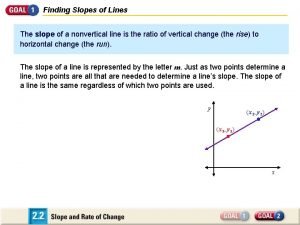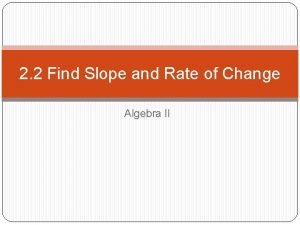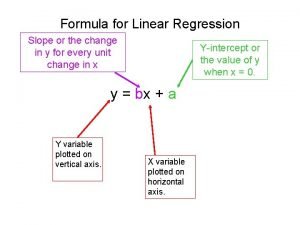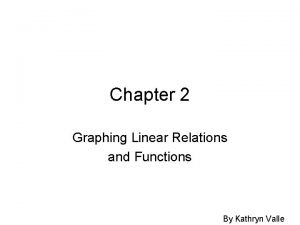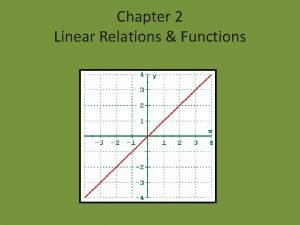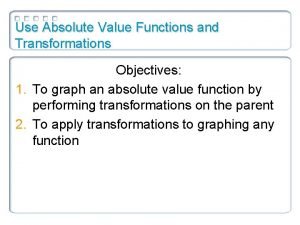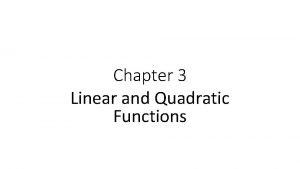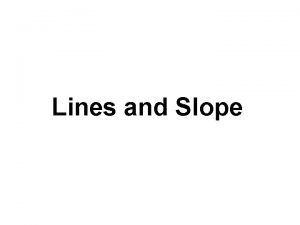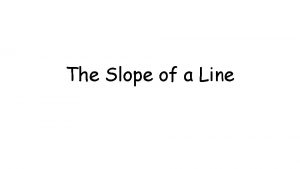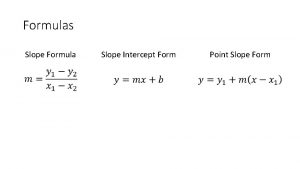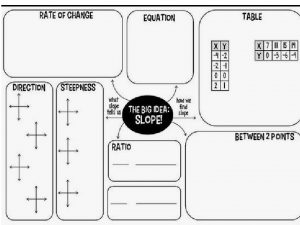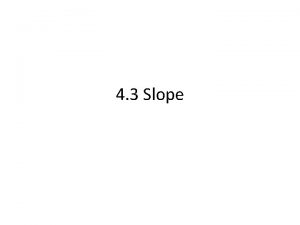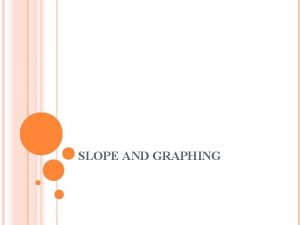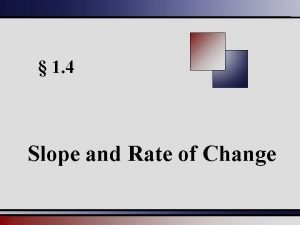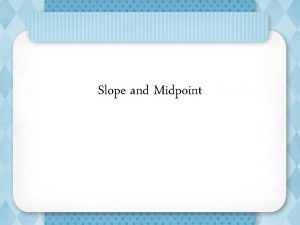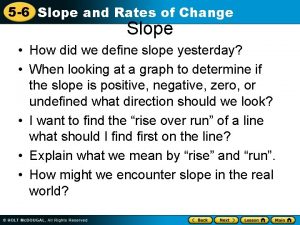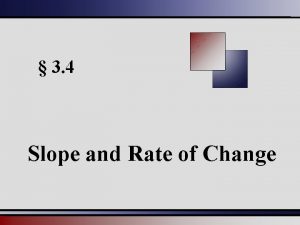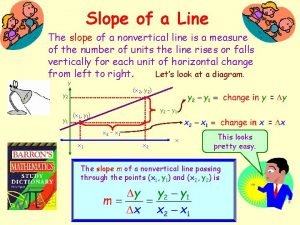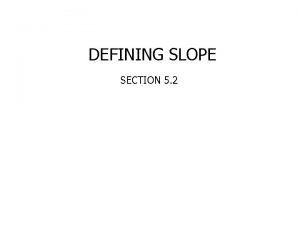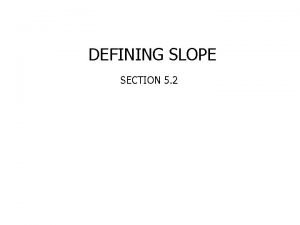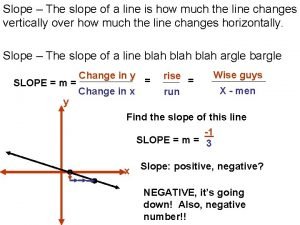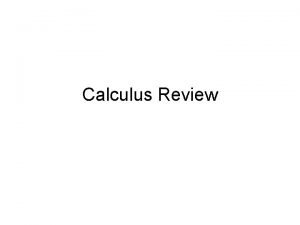2 4 Linear Functions and Slope Linear Functions



























- Slides: 27

2. 4 Linear Functions and Slope

Linear Functions All equations of the form Ax + By = C are straight lines when graphed, as long as A and B are not both zero. Such an equation is called the standard form of the equation of the line. To graph equations of this form, two very important points are used – the intercepts. Blitzer, Algebra for College Students, 6 e – Slide #2 Section 2. 4

x- and y-Intercepts Using Intercepts to Graph Ax + By = C 1) Find the x-intercept. Let y = 0 and solve for x. 2) Find the y-intercept. Let x = 0 and solve for y. 3) Find a checkpoint, a third ordered-pair solution. 4) Graph the equation by drawing a line through the three points. Blitzer, Algebra for College Students, 6 e – Slide #3 Section 2. 4

Graphing Using Intercepts EXAMPLE Graph the equation using intercepts. SOLUTION 1) Find the x-intercept. Let y = 0 and then solve for x. Replace y with 0 Multiply and simplify Divide by -2 The x-intercept is -6, so the line passes through (-6, 0). Blitzer, Algebra for College Students, 6 e – Slide #4 Section 2. 4

Graphing Using Intercepts CONTINUED 2) Find the y-intercept. Let x = 0 and then solve for y. Replace x with 0 Multiply and simplify Divide by 4 The y-intercept is 3, so the line passes through (0, 3). Blitzer, Algebra for College Students, 6 e – Slide #5 Section 2. 4

Graphing Using Intercepts CONTINUED 3) Find a checkpoint, a third ordered-pair solution. For our checkpoint, we will let x = 1 (because x = 1 is not the xintercept) and find the corresponding value for y. Replace x with 1 Multiply Add 2 to both sides Divide by 4 and simplify The checkpoint is the ordered pair (1, 3. 5). Blitzer, Algebra for College Students, 6 e – Slide #6 Section 2. 4

Graphing Using Intercepts CONTINUED 4) Graph the equation by drawing a line through the three points. The three points in the figure below lie along the same line. Drawing a line through the three points results in the graph of. (0, 3) (1, 3. 5) (-6, 0) Blitzer, Algebra for College Students, 6 e – Slide #7 Section 2. 4

Graphing Using Intercepts Your Turn Graph the equation using intercepts. SOLUTION 1) Find the x-intercept. 2) Find the y-intercept. 3) Find a checkpoint. 4) Graph the equation. . Blitzer, Algebra for College Students, 6 e – Slide #8 Section 2. 4

Slope of a Line The slope m of the line through the two distinct points and is m, where Note that you may call either point However, don’t subtract in one order in the numerator and use another order for subtraction in the denominator - or the sign of your slope will be wrong. Blitzer, Algebra for College Students, 6 e – Slide #9 Section 2. 4

Slope as Rate of Change The change in the y values is the vertical change or the “Rise”. The change in the x values is the horizontal change or the “Run. ” m is commonly used to denote the slope of a line. The absolute value of a line is related to its steepness. When the slope is positive, the line rises from left to right. When the slope is negative, the line falls from left to right. Blitzer, Algebra for College Students, 6 e – Slide #10 Section 2. 4

Slopes of Lines EXAMPLE Find the slope of the line passing through the pair of points. Then explain what the slope means. (-7, -8) and (4, -2) SOLUTION Remember, the slope is obtained as follows: This means that for every six units that the line (that passes through both points) travels up, it also travels 11 units to the right. Blitzer, Algebra for College Students, 6 e – Slide #11 Section 2. 4

Slopes of Lines Possibilities for a Line’s Slope Positive Slope Negative Slope Zero Slope Undefined Slope Blitzer, Algebra for College Students, 6 e – Slide #12 Section 2. 4

Slope Intercept Form In the form of the equation of the line where the equation is written as y = mx + b, is true that if x = 0, then y = b. it Therefore, b is the y intercept for the equation of the line. Furthermore, the x coefficient m is the slope of the line. This form of the equation is called the “Slope Intercept Form” since you can easily see both of these, the slope and the y intercept, in the actual equation. Blitzer, Algebra for College Students, 6 e – Slide #13 Section 2. 4

Slopes of Lines Slope-Intercept Form of the Equation of a Line y = mx + b with slope m, and y-intercept b Examples y =. 968 x – 17. 3 f (x) = 3 -5 x m =. 968; b = -17. 3 m = -5; b = 3 Blitzer, Algebra for College Students, 6 e – Slide #14 Section 2. 4

Slopes of Lines EXAMPLE Give the slope and y-intercept for the line whose equation is: 3 x - 5 y = 7 SOLUTION Hint: You should solve for y so as to have the equation in slope intercept form. 3 x - 5 y = 7 3 x - 5 y = -3 x+7 -5 y = -3 x+7 Subtract 3 x from both sides Simplify Divide both sides by -5 Simplify Therefore, the slope is 3/5 and the y-intercept is -7/5. Blitzer, Algebra for College Students, 6 e – Slide #15 Section 2. 4

Slopes of Lines Your Turn Find the slope of a line passing through the points (-3, 4) and (-4, -2) Give the slope and y-intercept for the line whose equation is: 3 x - 5 y = 7 Blitzer, Algebra for College Students, 6 e – Slide #16 Section 2. 4

Slopes of Lines Graphing y = mx + b Using the Slope and y-Intercept 1) Plot the point containing the y-intercept on the y-axis. This is the point (0, b). 2) Obtain a second point using the slope, m. Write m as a fraction, and use rise -over-run, starting at the point containing the y-intercept, to plot this point. 3) Use a straightedge to draw a line through the two points. Draw arrowheads at the ends of the line to show that the line continues indefinitely in both directions Blitzer, Algebra for College Students, 6 e – Slide #17 Section 2. 4

Graphing Lines EXAMPLE Graph the line whose equation is f (x) = 2 x + 3. SOLUTION The equation f (x) = 2 x + 3 is in the form y = mx + b. The slope is 2 and the y-intercept is 3. Now that we have identified the slope and the y-intercept, we use three steps in the box to graph the equation. Blitzer, Algebra for College Students, 6 e – Slide #18 Section 2. 4

Graphing Lines CONTINUED 1) Plot the point containing the y-intercept on the y-axis. The y-intercept is 3. We plot the point (0, 3), shown below. (0, 3) Blitzer, Algebra for College Students, 6 e – Slide #19 Section 2. 4

Graphing Lines CONTINUED 2) Obtain a second point using the slope, m. Write m as a fraction, and use rise over run, starting at the point containing the y-intercept, to plot this point. We express the slope, 2, as a fraction. (1, 5) We plot the second point on the line by starting at (0, 4), the first point. Based on the slope, we move 2 units up (the rise) and 1 unit to the right (the run). This puts us at a second point on the line, (1, -1), shown on the graph. Blitzer, Algebra for College Students, 6 e – Slide #20 Section 2. 4 (0, 3)

Graphing Lines CONTINUED 3) Use a straightedge to draw a line through the two points. The graph of y = 2 x + 3 is show below. (1, 5) (0, 3) Blitzer, Algebra for College Students, 6 e – Slide #21 Section 2. 4

Horizontal and Vertical Lines Equation of a Horizontal Line (0, b) A horizontal line is given by an equation of the form y = b where b is the yintercept. Equation of a Vertical Line A vertical line is given by an equation of the form x = a where a is the x-intercept. (a, 0) Blitzer, Algebra for College Students, 6 e – Slide #22 Section 2. 4

Horizontal and Vertical Lines EXAMPLE Graph the linear equation: y = -4. SOLUTION All ordered pairs that are solutions of y = -4 have a value of y that is always -4. Any value can be used for x. Let’s select three of the possible values for x: -3, 1, 6: x y = -4 (x, y) -3 -4 (-3, -4) 1 -4 (1, -4) 6 -4 (6, -4) (1, -4) (-3, -4) Upon plotting the three resultant points and connecting the points with a line, the graph to the right is the solution. Blitzer, Algebra for College Students, 6 e – Slide #23 Section 2. 4 (6, -4)

Horizontal and Vertical Lines EXAMPLE Graph the linear equation: x = 5. SOLUTION All ordered pairs that are solutions of x = 5 have a value of x that is always 5. Any value can be used for y. Let’s select three of the possible values for y: -3, 1, 5: (5, 5) x=5 y (x, y) 5 -3 (5, -3) 5 1 (5, 1) 5 5 (5, 5) (5, 1) (5, -3) Upon plotting the three resultant points and connecting the points with a line, the graph to the right is the solution. Blitzer, Algebra for College Students, 6 e – Slide #22 Section 2. 4

Slope as Rate of Change EXAMPLE A linear function that models data is described. Find the slope of each model. Then describe what this means in terms of the rate of change of the dependent variable y per unit change in the independent variable x. The linear function y = 2 x + 24 models the average cost in dollars of a retail drug prescription in the United States, y, x years after 1991. SOLUTION The slope of the linear model is 2. This means that every year (since 1991) the average cost in dollars of a retail drug prescription in the U. S. has increased approximately $2. Blitzer, Algebra for College Students, 6 e – Slide #23 Section 2. 4

Linear Modeling EXAMPLE Find a linear function, in slope-intercept form or a constant function that models the given description. Describe what each variable in your model represents. Then use the model to make a prediction. In 1998, there were 84 million Internet users in the United States and this number has increased at a rate of 21 million users per year since then. SOLUTION I(x) = 21 x + 84, where I(x) is the number of U. S. Internet users (in millions) x years after 1998. We predict in 2010, there will be I(12) = 21(12) + 84 = 336 million U. S. Internet users. Blitzer, Algebra for College Students, 6 e – Slide #24 Section 2. 4

2. 4 Assignments p. 140 (6 -14 even, 16, 20, 24 -32 even, 42 -52 even, 56)
 Slope intercept form part 2
Slope intercept form part 2 The difference between slope decline and slope retreat
The difference between slope decline and slope retreat Converting point slope to slope intercept
Converting point slope to slope intercept Slopes of lines
Slopes of lines Slope review classifying slope
Slope review classifying slope Linear regression slope formula
Linear regression slope formula How to rewrite in slope intercept form
How to rewrite in slope intercept form Slope intercept form simplifier
Slope intercept form simplifier Difference between exponential and linear functions
Difference between exponential and linear functions Modeling with quadratic functions
Modeling with quadratic functions Simple and multiple linear regression
Simple and multiple linear regression Types of linear text
Types of linear text Non linear narrative definition
Non linear narrative definition Linear pipeline
Linear pipeline Disadvantages of non linear multimedia
Disadvantages of non linear multimedia Principle of linear impulse and momentum formula
Principle of linear impulse and momentum formula Persamaan linear simultan
Persamaan linear simultan Left linear
Left linear Difference between linear and nonlinear analysis
Difference between linear and nonlinear analysis Metode numerik sistem persamaan linear
Metode numerik sistem persamaan linear Linear quadratic exponential
Linear quadratic exponential Linear vs nonlinear table
Linear vs nonlinear table Linear relations and functions
Linear relations and functions Transformation linear function
Transformation linear function 2-2 linear relations and functions
2-2 linear relations and functions Absolute value graph transformations
Absolute value graph transformations Graphing linear and exponential functions
Graphing linear and exponential functions Chapter 3 linear and quadratic functions
Chapter 3 linear and quadratic functions



